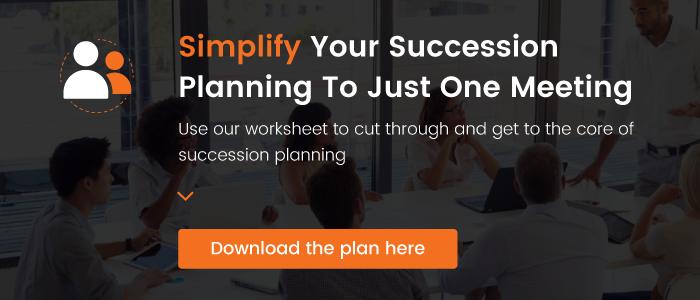04th July 2017
How to use your talent pool to supercharge succession planning
Succession planning involves ensuring that your current success is maintained and grown in the future. It relies on a practical talent management strategy and skills gap analysis to identify and develop team members to replace key roles within an organisation.
People leave organisations for one of the four general reasons:
- Retirement
- Resignation
- Dismissal
- Ill health, death or accident
You may receive some level of warning for the first three events. However, ill health and accidents can happen overnight and require an immediate response. In these situations a succession planning process which prepares a host of potential leaders to step up as a replacement is crucial.
When a key leader does move on they don’t just leave a spare seat behind – they take all of their personal knowledge of what works in your organisation with them. This knowledge includes, but is not limited to:
- The history of your organisation, including key decisions and important moments of change
- An awareness of how things are done, including the invisible things like cultural practices and values
- Relationships within and outside the organisation – in particular critical client connections
As a result preparing a talent pool of strong future leaders is essential for your organisation’s future success.
Why talent pools are important for effective succession planning
There are two obvious strategies for succession planning success.
- The first involves bringing people in from the outside. Whilst this can be effective, bringing new ideas and momentum, it can run the risk of not delivering the very thing that your succession planning process is designed to provide: continuity.
- The alternative is to develop talent capable of leading change in the near and medium term future within your current team of employees.
Both approaches involve the careful management of your talent pool. They are a great way to spread the risk and responsibility of succession planning across a group of high-performing, high-potential candidates rather than a single individual.
The golden rule for creating a talent pool for your succession planning is choice. When the time comes to choose a successor you want to have a good selection of candidates to select from.
5 key insights for building your succession planning talent pool
1. Continually forecast succession planning needs
Succession planning is not about what you need today. It’s about talent development for the near future. You therefore need to continually forecast the future needs of your company and work out what characteristics will be particularly important for a leader to have.
To develop a solid plan you need to be thinking about the the business strategy, the evolving capability needs your organisation may have, and the competitive landscape you operate in – will the market or customer needs change, and will there be a requirement for new skills?
You may also need to stay on top of the trends and be seen as a progressive, desirable workplace. For instance, consider how working from home, paid time off and proper onboarding may influence your succession planning model. This should be included in your planning and in the training to prepare your team members for leading change in the future.
2. Work your skills gap analysis
Your succession planning strategies should be based on the gap between what your candidates currently have and what they will need tomorrow when your current leaders step aside. Consider details around:
- What roles do you need for leading change now and in the future?
- Who is in your current talent pool?
- What qualities, skills and experiences will they need to be effective leaders?
- What training and development programs do you need to develop this pool of leaders?
- How will you consistently engage these potential leaders so they don’t leave to pursue opportunities in other organisations?
3. Promote diversity in your talent pools
The stronger and more diverse your talent pool is, the greater your chance of finding the right candidate at the time they need to be appointed. Our experience suggests that you don’t get diversity unless you plan and take deliberate actions to make things happen.
Cultural and ethnic diversity is known to alter the behaviour of a group in a way that leads to improved and more accurate group thinking. In addition, diversity in terms of the range of experience, both within your organisation and outside it in related industries, can lead to innovation within your processes.
4. Remember to use digital tools
By using the right digital tools to manage your talent pool you can keep track of all potential successors by creating profiles of their records, interview notes, talents, weaknesses and completed training.
This can help you efficiently manage data as well as streamline the hiring process. Cloud-based subscription systems are effective, can prevent becoming a slave to documentation, and allow real time review and updating of records.
5. Create a talent development community
Your aim should not be to prepare a single future leader; it should be to build a community of future leaders to draw from. Think of your talent pool and succession planning process as building a group of people to lead your organisation forward.
In the case of external talent pools, it can be helpful to create a communal online platform or social media hub to bring all potential candidates together. This will give your candidates a window into the company and allow you to promote its culture.
Plus, it will encourage members to learn from each other, keeping them engaged in what your organisation is building. For positions where you often have multiple roles to fill (sales reps, developers, etc.) your talent acquisition team or external partner should be creating and nurturing a ‘ready to move’ external talent pool to draw from.
Developing a strong, diverse talent pool takes long-term commitment. But it’s a vital component of your succession planning model, and essential for ensuring the longevity of your organisation.
To position your internal talent pool as a useful tool for succession planning it’s a good idea to use the below template. It uses a simple “one question” framework to help you identify potential successors across your organisation, and outline the development required to ready them for a new role.
Categories: Developing Leaders





